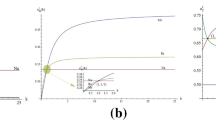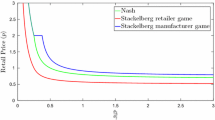Abstract
Two kinds of vertical cooperative advertising program are considered in a distribution channel constituted by a manufacturer and a retailer, where the manufacturer pays part of the retailer’s advertising costs. In the first participation scheme, the manufacturer chooses his/her advertising participation rate in the retailer’s advertising effort and then each player determines the advertising effort that maximizes his/her profit. In the second scheme, the retailer chooses the manufacturer’s participation rate and then the manufacturer determines the advertising efforts of both players with the objective of maximizing the manufacturer’s profit. Each participation scheme corresponds to a special Stackelberg game: the manufacturer is the leader of the first, while the retailer is the leader of the second. The Stackelberg equilibrium advertising efforts and participation rate in both games are provided. Then the equilibrium strategies of the two players in the analyzed scenarios are compared with the Nash equilibrium in the competitive framework. Finally, the conditions which suggest a special kind of agreement to a player are analyzed.
Similar content being viewed by others
References
Bergen M, John G (1997) Understanding cooperative advertising participation rates in conventional media. J Mark Res 34:357–369
Buratto A, Viscolani B (2002) New product introduction: goodwill, time and advertising cost. Math Methods Oper Res 55:55–68
Chintagunta PK, Jain D (1992) A dynamic model of channel members strategies for marketing expenditures. Mark Sci 11(2):168–188
Feichtinger G, Hartl RF, Sethi SP (1994) Dynamic optimal control models in advertising: recent developments. Manag Sci 40(2):195–226
Grosset L, Viscolani B (2004) Advertising for a new product introduction: a stochastic approach. Top: Trab Investig Oper 12(1):55–68
Jeuland AP, Shugan SM (1983) Managing channel profits. Mat 2:239–272
Jørgensen S, Zaccour G (1999) Equilibrium pricing and advertising strategies in a marketing channel. J Optim Theory Appl 102(1):111–125
Jørgensen S, Zaccour G (2003a) Channel coordination over time: incentive equilibria and credibility. J Econ Dyn Control 27(5):801–822
Jørgensen S, Zaccour G (2003b) A differential game of retailer promotions. Automatica 39:1145–1155
Jørgensen S, Zaccour G (2004) Differential games in marketing. Kluwer Academic, Boston
Jørgensen S, Taboubi S, Zaccour G (2001) Cooperative advertising in a marketing channel. J Optim Theory Appl 110(1):145–158
Karray S, Zaccour G (2007) Effectiveness of coop advertising programs in competitive distribution channels. Int Game Theory Rev 9(2):151–167
Karray S, Sigué SP, Zaccour G (2001) Stackelberg leadership in a marketing channel. Int Game Theory Rev 3(1):13–26
Kotler P (2003) Marketing management. Prentice-Hall, Upper Saddle River
Li SX, Huang Z, Zhu J, Chau PYK (2002) Cooperative advertising, game theory and manufacturer-retailer supply chains. Omega 30(5):347–357
Nerlove M, Arrow JK (1962) Optimal advertising policy under dynamic conditions. Economica 29:129–142
Rogers EM (1995) Diffusion of innovations. The Free Press, New York
Sethi SP (1977) Dynamic optimal control models in advertising: a survey. SIAM Rev 19(4):685–725
Author information
Authors and Affiliations
Corresponding author
Additional information
This work was supported by the Italian Ministry of University and Research and the University of Padua.
Rights and permissions
About this article
Cite this article
Buratto, A., Grosset, L. & Viscolani, B. Advertising coordination games of a manufacturer and a retailer while introducing a new product. TOP 15, 307–321 (2007). https://doi.org/10.1007/s11750-007-0019-y
Received:
Accepted:
Published:
Issue Date:
DOI: https://doi.org/10.1007/s11750-007-0019-y




